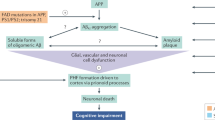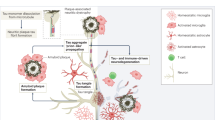Abstract
Alzheimer's disease constitutes a personal and societal tragedy of immense proportions. Since 1960, research in laboratories and clinics worldwide has elucidated many features of this insidious and ultimately fatal syndrome, and this progress has led to initial human trials of potentially disease-modifying agents. However, some of these agents have already failed. Gnawing controversies and important gaps in our knowledge seem to cast additional doubt on the ability of the field to move forward effectively. Here I discuss some of these looming concerns and offer possible explanations for the major trial failures that suggest they are not predictive of the future. Rigorous preclinical validation of mechanism-based therapeutic agents followed by meticulously designed trials that focus on the cardinal cognitive symptoms and their associated biomarkers in the mild or presymptomatic phases of Alzheimer's disease are likely to lead to success, perhaps in the not-too-distant future.
This is a preview of subscription content, access via your institution
Access options
Subscribe to this journal
Receive 12 print issues and online access
$209.00 per year
only $17.42 per issue
Buy this article
- Purchase on Springer Link
- Instant access to full article PDF
Prices may be subject to local taxes which are calculated during checkout


Similar content being viewed by others
Change history
21 October 2011
In the version of this article initially published, the name of the antibody bapineuzumab is incorrectly spelled as 'bapineuzimab' throughout the text. The error has been corrected in the HTML and PDF versions of the article.
References
Jack, C.R. Jr. et al. Hypothetical model of dynamic biomarkers of the Alzheimer's pathological cascade. Lancet Neurol. 9, 119–128 (2010).
Pimplikar, S.W., Nixon, R.A., Robakis, N.K., Shen, J. & Tsai, L.H. Amyloid-independent mechanisms in Alzheimer's disease pathogenesis. J. Neurosci. 30, 14946–14954 (2010).
Hardy, J. & Selkoe, D.J. The amyloid hypothesis of Alzheimer's disease: progress and problems on the road to therapeutics. Science 297, 353–356 (2002).
Tanzi, R.E. & Bertram, L. Twenty years of the Alzheimer's disease amyloid hypothesis: a genetic perspective. Cell 120, 545–555 (2005).
Haass, C. & Selkoe, D.J. Soluble protein oligomers in neurodegeneration: Lessons from the Alzheimer's amyloid β-peptide. Nat. Rev. Mol. Cell Biol. 8, 101–112 (2007).
Holtzman, D.M., Morris, J.C. & Goate, A.M. Alzheimer's disease: the challenge of the second century. Sci. Transl. Med. 3, 77sr71 (2011).
Corder, E.H. et al. Gene dose of apolipoprotein E type 4 allele and the risk of Alzheimer's disease in late onset families. Science 261, 921–923 (1993).
Schmechel, D.E. et al. Increased amyloid β-peptide deposition in cerebral cortex as a consequence of apolipoprotein E genotype in late-onset Alzheimer disease. Proc. Natl. Acad. Sci. USA 90, 9649–9653 (1993).
Rebeck, G.W., Reiter, J.S., Strickland, D.K. & Hyman, B.T. Apolipoprotein E in sporadic Alzheimer's disease: allelic variation and receptor interactions. Neuron 11, 575–580 (1993).
Holtzman, D.M. et al. Apolipoprotein E isoform-dependent amyloid deposition and neuritic degeneration in a mouse model of Alzheimer's disease. Proc. Natl. Acad. Sci. USA 97, 2892–2897 (2000).
Koffie, R.M. et al. Oligomeric amyloid b associates with postsynaptic densities and correlates with excitatory synapse loss near senile plaques. Proc. Natl. Acad. Sci. USA 106, 4012–4017 (2009).
Knowles, R.B. et al. Plaque-induced neurite abnormalities: implications for disruption of neural networks in Alzheimer's disease. Proc. Natl. Acad. Sci. USA 96, 5274–5279 (1999).
Shankar, G.M. et al. Amyloid-β protein dimers isolated directly from Alzheimer's brains impair synaptic plasticity and memory. Nat. Med. 14, 837–842 (2008).
Castellano, J.M. et al. Human apoE isoforms differentially regulate brain amyloid-{b} peptide clearance. Sci. Transl. Med. 3, 89ra57 (2011).
Hyman, B.T. et al. Quantitative analysis of senile plaques in Alzheimer's disease: observation of log-normal size distribution and molecular epidemiology of differences associated with apolipoprotein E genotype and trisomy 21 (Down syndrome). Proc. Natl. Acad. Sci. USA 92, 3586–3590 (1995).
Yan, P. et al. Characterizing the appearance and growth of amyloid plaques in APP/PS1 mice. J. Neurosci. 29, 10706–10714 (2009).
Lemere, C.A. et al. Sequence of deposition of heterogeneous amyloid β-peptides and Apo E in Down syndrome: Implications for initial events in amyloid plaque formation. Neurobiol. Dis. 3, 16–32 (1996).
Kamenetz, F. et al. APP processing and synaptic function. Neuron 37, 925–937 (2003).
Puzzo, D. et al. Picomolar amyloid-β positively modulates synaptic plasticity and memory in hippocampus. J. Neurosci. 28, 14537–14545 (2008).
Goate, A. et al. Segregation of a missense mutation in the amyloid precursor protein gene with familial Alzheimer's disease. Nature 349, 704–706 (1991).
Sherrington, R. et al. Cloning of a novel gene bearing missense mutations in early onset familial Alzheimer disease. Nature 375, 754–760 (1995).
Hutton, M. et al. Association of missense and 5′-splice-site mutations in tau with the inherited FTDP-17. Nature 393, 702–705 (1998).
Götz, J., Chen, F., van Dorpe, J. & Nitsch, R.M. Formation of neurofibrillary tangles in P301l tau transgenic mice induced by Aβ 42 fibrils. Science 293, 1491–1495 (2001).
Lewis, J. et al. Enhanced neurofibrillary degeneration in transgenic mice expressing mutant tau and APP. Science 293, 1487–1491 (2001).
Roberson, E.D. et al. Reducing endogenous tau ameliorates amyloid b–induced deficits in an Alzheimer's disease mouse model. Science 316, 750–754 (2007).
Ittner, L.M. et al. Dendritic function of tau mediates amyloid-β toxicity in Alzheimer's disease mouse models. Cell 142, 387–397 (2010).
De Felice, F.G. et al. Alzheimer's disease-type neuronal tau hyperphosphorylation induced by A b oligomers. Neurobiol. Aging 29, 1334–1347 (2008).
Jin, M., Shepardson, N., Yang, T., Walsh, D. & Selkoe, D. Soluble amyloid β-protein dimers isolated from Alzheimer cortex directly induce Tau hyperphosphorylation and neuritic degeneration. Proc. Natl. Acad. Sci. USA 108, 5819–5824 (2011).
Gozes, I. et al. Addressing Alzheimer's disease tangles: from NAP to AL-108. Curr. Alzheimer Res. 6, 455–460 (2009).
Golde, T.E., Schneider, L.S. & Koo, E.H. Anti-Aβ therapeutics in Alzheimer's disease: the need for a paradigm shift. Neuron 69, 203–213 (2011).
Sperling, R.A. et al. Toward defining the preclinical stages of Alzheimer's disease: Recommendations from the National Institute on Aging-Alzheimer's Association workgroups on diagnostic guidelines for Alzheimer's disease. Alzheimers Dement. 7, 280–292 (2011).
Oddo, S., Billings, L., Kesslak, J.P., Cribbs, D.H. & LaFerla, F.M. Aβ immunotherapy leads to clearance of early, but not late, hyperphosphorylated tau aggregates via the proteasome. Neuron 43, 321–332 (2004).
Salloway, S. et al. A phase 2 multiple ascending dose trial of bapineuzumab in mild to moderate Alzheimer disease. Neurology 73, 2061–2070 (2009).
Faux, N.G. et al. PBT2 rapidly improves cognition in Alzheimer's disease: additional phase II analyses. J. Alzheimers Dis. 20, 509–516 (2010).
Rinne, J.O. et al. 11C-PiB PET assessment of change in fibrillar amyloid-β load in patients with Alzheimer's disease treated with bapineuzumab: a phase 2, double-blind, placebo-controlled, ascending-dose study. Lancet Neurol. 9, 363–372 (2010).
Gilman, S. et al. Clinical effects of Aβ immunization (AN1792) in patients with Alzheimer's disease in an interrupted trial. Neurology 64, 1553–1562 (2005).
Holmes, C. et al. Long-term effects of Aβ42 immunisation in Alzheimer's disease: follow-up of a randomised, placebo-controlled phase I trial. Lancet 372, 216–223 (2008).
Serrano-Pozo, A. et al. Beneficial effect of human anti–amyloid-β active immunization on neurite morphology and tau pathology. Brain 133, 1312–1327 (2010).
Author information
Authors and Affiliations
Ethics declarations
Competing interests
D.J.S. is a founding scientist of Athena Neurosciences and a consultant to Elan plc. He is also a consultant to Johnson & Johnson in neuroscience.
Rights and permissions
About this article
Cite this article
Selkoe, D. Resolving controversies on the path to Alzheimer's therapeutics. Nat Med 17, 1060–1065 (2011). https://doi.org/10.1038/nm.2460
Published:
Issue Date:
DOI: https://doi.org/10.1038/nm.2460
This article is cited by
-
Multifunctional Nanocarriers for Alzheimer’s Disease: Befriending the Barriers
Molecular Neurobiology (2023)
-
Task-dependent learning and memory deficits in the TgF344-AD rat model of Alzheimer’s disease: three key timepoints through middle-age in females
Scientific Reports (2022)
-
Deep Sea Water Alleviates Tau Phosphorylation and Cognitive Impairment via PI3K/Akt/GSK-3β Pathway
Marine Biotechnology (2022)
-
X-ray multiscale 3D neuroimaging to quantify cellular aging and neurodegeneration postmortem in a model of Alzheimer’s disease
European Journal of Nuclear Medicine and Molecular Imaging (2022)
-
Identification and drug-induced reversion of molecular signatures of Alzheimer’s disease onset and progression in AppNL-G-F, AppNL-F, and 3xTg-AD mouse models
Genome Medicine (2021)



